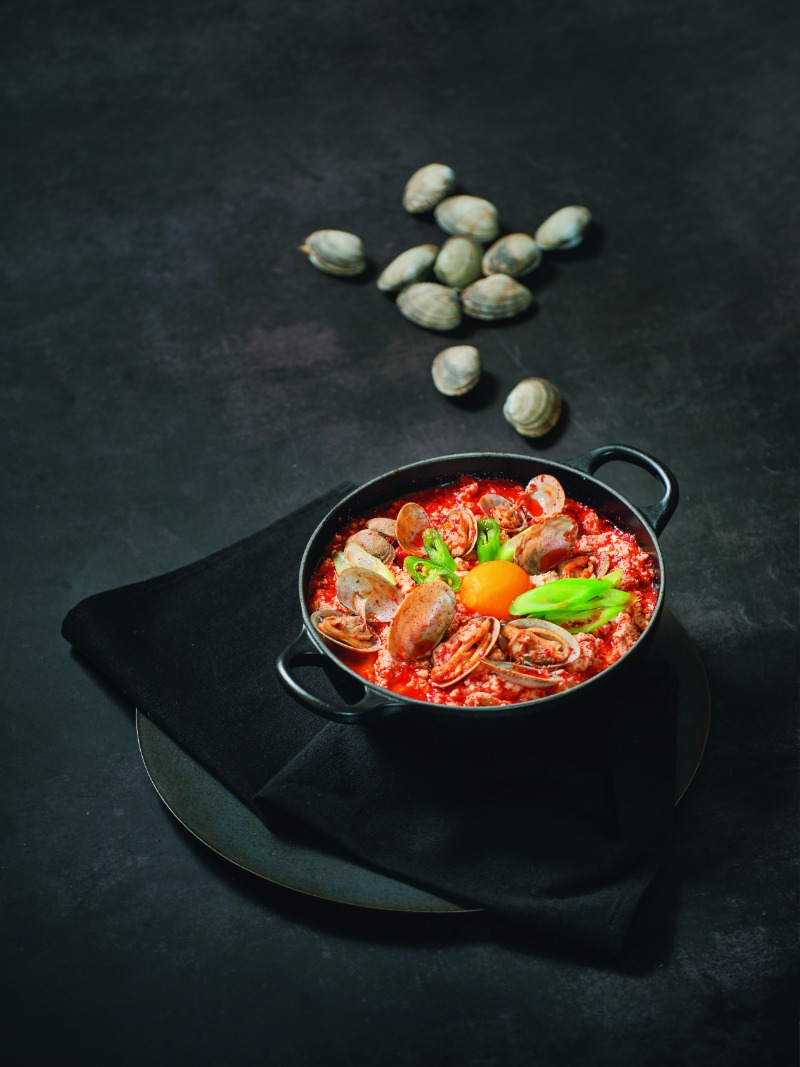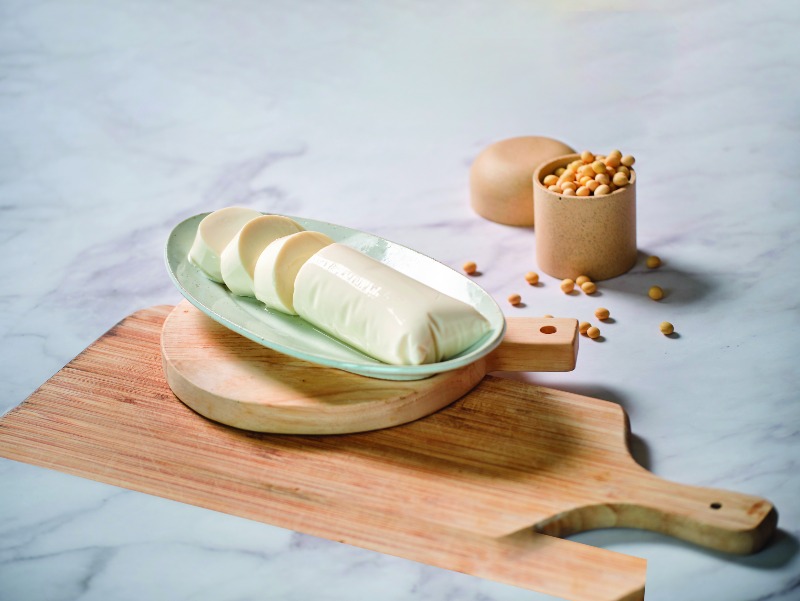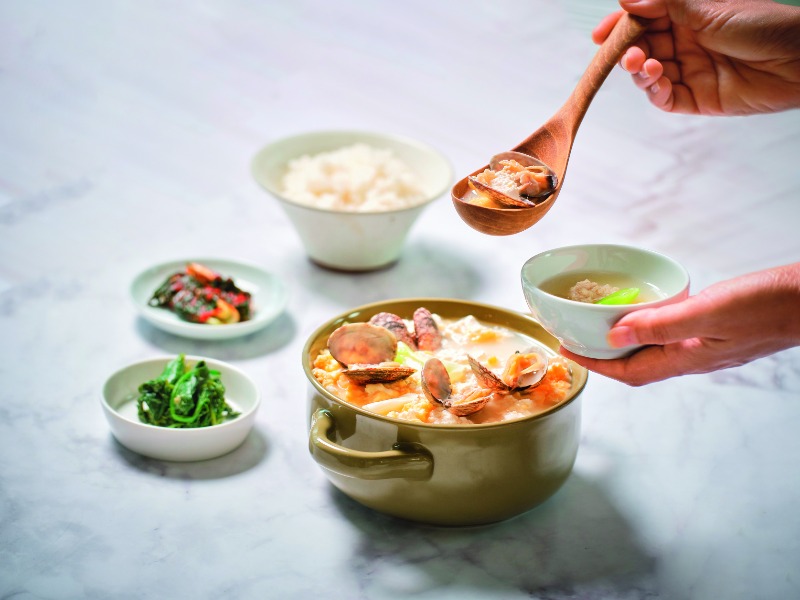Sundubu, a type of soft tofu with a distinctively light taste and texture, is enjoyed by Koreans for its smooth flavor and health benefits. It is often used to make a spicy stew that is still bubbling furiously when brought to the table.

Sundubu is prized for its versatility. It can be combined with clams to make bajirak sundubu jjigae, added to a spicy seafood broth to make jjamppong sundubu jjigae, or even mixed into a kimchi stew. The pairings seem endless.
The light texture and neutral flavor of sundubu (soft tofu) make it an ideal partner for meat and vegetable dishes and stews bursting with flavor and personality. Sundubu on its own might seem somewhat plain and unassuming. However, that all changes the moment it is added to stews to take on new life as a hot, spicy, and tasty treat. Sundubu jjigae (soft tofu stew) is one of the most popular Korean stews along with kimchi jjigae and doenjang jjigae.
In Korea, tofu is known as the “meat of the fields” because of its protein punch. Meat was not affordable to most households before the nation industrialized and prospered. Stews with tofu thus became a favored way of getting protein as well as amino acids to aid digestion.
For those who know how tofu is made, the steps for making sundubu might sound familiar. Soy milk is brought to a boil, to which salt water is then added and stirred until the soy proteins begin to coagulate. Once the soy milk starts to curdle into soft chunks and separates from the water, the resulting silky bean curd is removed along with the water sitting on top to make sundubu. To make regular tofu, a coagulant is added at this stage to allow the curds to harden into firm chunks.
EXTRA SPICY

Fittingly, in addition to its silky texture and delicate flavor, sundubu is easy to digest. Thanks to its high protein content, it is also incredibly filling but not heavy on the stomach, making it a popular weight-loss food.
To fully appreciate the inherently subtle flavor of sundubu, it should be eaten hot and chewed slowly. There are many variations of
sundubu jjigae. The most common image of this dish features soft tofu floating in a spicy broth made with red pepper powder. The stew is brought to a boil and served seething hot while still bubbling loudly.
The fluffy, snow-white bean curd helps tamp down the spiciness of the red pepper to produce a mild and delicate flavor. Thanks to the silky texture, the bean curd seems to melt in the mouth, like a warm pudding.
An egg or seafood are often added to complement the flavor and depth. This is the case in Seoul, where an egg and baby clams are commonly added to
The Gyeongsang region is where foodies can test their heat tolerance. It is common to fry green onions and red pepper powder together toa spicy oil, which is poured into the sundubu jjigae broth before it is boiled. The resulting stew has a more intense flavor as well as extra burn. Chili oil is also a staple in Daegu, Korea’s fourth-largest city, where it is essential in sundubu jjigae as well as haejangguk, a soup favored by many after a night of heavy drinking.
The Jeolla region, hugging the southwest coast of the Korean peninsula, is known for jeotgal, salted and fermented seafood. Shrimp jeotgal (saeujeot) is often used to lace stews. It is featured in a salty and savory version of sundubu jjigae that is made with summer squash. The Chungcheong provinces, on the northern border of the Jeolla region, are famous for jjageuri, a stew that may be mistaken for a stir-fry. The broth is reduced to a thick consistency and ladled onto or mixed into rice.
NOT ALWAYS SPICY

Most variations of sundubu jjigae are spicy and packed with flavor, but in Gangneung’s Chodang Village, the dish is also served without added seasoning for those who would rather enjoy the tofu’s inherently light flavor.
There is also a clear-broth version of sundubu jjigae for those who don’t want to overwhelm the delicacy of the tofu. The birthplace of this dish is widely regarded to be Gangneung, a city in Gangwon Province on the east coast of the Korean peninsula.
In Gangneung, the sundubu sold in Chodang Village is particularly famous, thanks to locally sourced soybeans. Beans grown in the rich and fertile soil of Gangwon Province combined with pristine saltwater from the nearby East Sea result in sundubu with a distinctively nutty flavor and some of the original texture of the soybeans. Though not as silky as typical sundubu, many Koreans prefer the Gangneung version and consider it to be the real deal.
Heo Yeop, a Joseon Dynasty scholar and government official who lived in the 16th century, is credited as the godfather of Chodang Village sundubu. While serving a government post in Gangneung, Heo Yeop fell in love with the taste of the spring water from the well in the office yard and had his cooks use the well water and saltwater from the nearby sea to make tofu. The name “Chodang” in Chodang tofu and Chodang Village is in fact Heo Yeop’s pen name.
Gangneung still boasts many restaurants serving sundubu made the traditional way. In fact, Chodang sundubu has become its own brand of sorts that has been applied to sundubu ice cream and gelato.
OFFBEAT RESTAURANTS
Many restaurants in Korea can be found using sundubu in unconventional ways. For example, Donghwa Garden in Gangneung sells a spicy seafood soup with sundubu called jjamppong sundubu. Jjamppong is a spicy Korean noodle dish with a mélange of seafood ingredients. It is a take on a traditional Chinese dish, and Donghwa Garden decided to go a step further by adding sundubu. A generous amount of seafood is just an added bonus. This establishment has turned into one of the most sought-after restaurants in Korea, which is evidenced by the long lines of people waiting outside the door every day.
Gangneung Sundubu Jang Kalguksu, as one might surmise from the name, is a restaurant specializing in kalguksu (handmade, knife-cut noodles) with sundubu. This soup is laden with two traditional Korean condiments: doenjang, or fermented soybean paste, and gochujang, or fermented red pepper paste. Once the two condiments have been brewed into a spicy broth, flat-cut noodles are added with sundubu, zucchini, and shiitake. A true delight, the rich-tasting broth warms you up from the inside out. The restaurant recommends starting with the noodles before diving into the heaps of soft, fluffy sundubu.
Seoul, too, has many restaurants serving their own variety of sundubu jjigae. For example, Opal Sikdang serves it with finely minced pork. Geobugi Sikdang, which specializes in pork barbecue, also has its own signature pork sundubu jjigae, which is offered in the form of a large jeongol (Korean-style hotpot) that serves three to four people. Cooked at the table, it comes in a huge pot filled with pork and sundubu and is eaten after being brought to a roiling boil.
Plain but brimming with flavor, unassuming but full of character — sundubu jjigae may very well be the quintessential Korean dish. Now it is capturing the attention of food lovers elsewhere. Today, the crimson stew brimming with soft, nutritious tofu is also finding its way on menus and tables around the world.
Hwang Hae-won Editor-in-chief, Food Service Management
Lee Min Hee Photographer